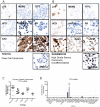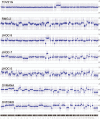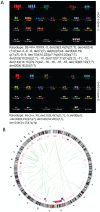Type-specific cell line models for type-specific ovarian cancer research
- PMID: 24023729
- PMCID: PMC3762837
- DOI: 10.1371/journal.pone.0072162
Type-specific cell line models for type-specific ovarian cancer research
Erratum in
- PLoS One. 2013;8(10). doi:10.1371/annotation/856f0890-9d85-4719-8e54-c27530ac94f4
-
Correction: Type-Specific Cell Line Models for Type-Specific Ovarian Cancer Research.PLoS One. 2013 Sep 27;8(9):10.1371/annotation/ffcaf179-872f-470b-8bb6-f06d8ba6d03a. doi: 10.1371/annotation/ffcaf179-872f-470b-8bb6-f06d8ba6d03a. eCollection 2013. PLoS One. 2013. PMID: 24116245 Free PMC article.
Abstract
Background: OVARIAN CARCINOMAS CONSIST OF AT LEAST FIVE DISTINCT DISEASES: high-grade serous, low-grade serous, clear cell, endometrioid, and mucinous. Biomarker and molecular characterization may represent a more biologically relevant basis for grouping and treating this family of tumors, rather than site of origin. Molecular characteristics have become the new standard for clinical pathology, however development of tailored type-specific therapies is hampered by a failure of basic research to recognize that model systems used to study these diseases must also be stratified. Unrelated model systems do offer value for study of biochemical processes but specific cellular context needs to be applied to assess relevant therapeutic strategies.
Methods: We have focused on the identification of clear cell carcinoma cell line models. A panel of 32 "ovarian cancer" cell lines has been classified into histotypes using a combination of mutation profiles, IHC mutation-surrogates, and a validated immunohistochemical model. All cell lines were identity verified using STR analysis.
Results: Many described ovarian clear cell lines have characteristic mutations (including ARID1A and PIK3CA) and an overall molecular/immuno-profile typical of primary tumors. Mutations in TP53 were present in the majority of high-grade serous cell lines. Advanced genomic analysis of bona-fide clear cell carcinoma cell lines also support copy number changes in typical biomarkers such at MET and HNF1B and a lack of any recurrent expressed re-arrangements.
Conclusions: As with primary ovarian tumors, mutation status of cancer genes like ARID1A and TP53 and a general immuno-profile serve well for establishing histotype of ovarian cancer cell We describe specific biomarkers and molecular features to re-classify generic "ovarian carcinoma" cell lines into type specific categories. Our data supports the use of prototype clear cell lines, such as TOV21G and JHOC-5, and questions the use of SKOV3 and A2780 as models of high-grade serous carcinoma.
Conflict of interest statement
Figures



References
-
- Auersperg N (2011) The origin of ovarian carcinomas: a unifying hypothesis. Int J Gynecol Pathol 30: 12–21. - PubMed
-
- Kalloger SE, Kobel M, Leung S, Mehl E, Gao D, et al. (2011) Calculator for ovarian carcinoma subtype prediction. Mod Pathol 24: 512–521. - PubMed
-
- Soslow RA (2008) Histologic subtypes of ovarian carcinoma: an overview. Int J Gynecol Pathol 27: 161–174. - PubMed
Publication types
MeSH terms
Substances
LinkOut - more resources
Full Text Sources
Other Literature Sources
Medical
Molecular Biology Databases
Research Materials
Miscellaneous

